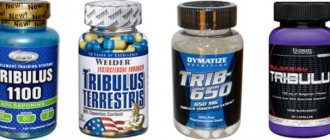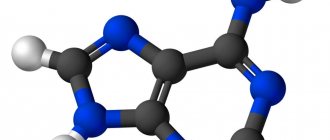Not all fats are the same. Some of them are important solely as a source of energy, while others have a wider range of beneficial properties. A substance called CLA is gaining more and more supporters among gym goers, bodybuilders and people wanting to lose weight. And for everyone who has not heard about this substance before, it’s time to find out what it is.
What is CLA?
Content:
- What is CLA?
- What does it contain?
- CLA and Linoleic Acid: What's the Difference?
- Linoleic and lipoic acid: what is the difference
- What is the benefit of fat?
- Role in the body
- Some benefits for the body
- What products contain
- Is CLA in food good for you?
- CLA as a supplement
- Is it true that CLA helps you lose weight?
- Benefits for athletes
- When and how to take
- What forms does it come in?
- Overdose and side effects
- Use in cosmetics
CLA, or conjugated linoleic acid (CLA), belongs to the 18-carbon family of omega fatty acids. More precisely, it is a group of isomers of linoleic acid with two double bonds separated by a methyl group.
In order to understand what CLA is, you first need to understand what the term “conjugated” means, since everything is more or less clear with the other two words in the name.
So, in the name CLA, this term indicates the presence of double bonds in the fatty acid molecule. And the conjugation (conjugation) of these double bonds can occur in different parts of the molecular chain. That is, conjugated fatty acids are those whose structural formula provides for the presence of double bonds between carbon atoms.
There are 28 forms of CLA, but the most important ones are c9t11 and t10c12. The formula of each CLA isomer indicates the presence of cis (c) and trans (t) double bonds. The numbers next to the letters indicate the location of these bonds on the fatty acid chain. The difference between the forms of CLA lies precisely in the variable placement of these double bonds. And this seemingly insignificant difference can radically change the properties of the acid and its role in the body.
But there are other isomers of CLA. For example:
- 9-trans, 11-trans;
- t11,c13;
- 8t10c;
- 9-hydroxy-trans 12-cis (source – Valerian Fori, teardrop seeds).
By the way, there is reason to believe that the latter isomer suppresses fat accumulation 8 times better than the basic isomer t10c12. And the 13-oxo-CLA isomer has twice the biological activity of c9t11.
Thus, CLA is a type of polyunsaturated fatty acid with cis and trans double bonds. In other words, CLA is technically a trans fat, but it is a naturally occurring trans fat and is found in many healthy foods. Scientists have conducted many studies and they all confirmed: while industrial trans fats are harmful to humans, natural CLA are not.
Notes[edit | edit code]
- Williams, Lane; Publishing, Woodland (1999-01). CLA: Conjugated Linoleic Acid - Google Book Search. Woodland Publishing.
- Zulet MA, Marti A, Parra MD, Martínez JA (September 2005). "Inflammation and conjugated linoleic acid: mechanisms of action and implications for human health." J. Physiol. Biochem. 61(3):483–94.
- Whigham Let al.; Watras, A.C.; Schoeller, D. A. (January 2007). "Efficacy of conjugated linoleic acid for reducing fat mass: a meta-analysis in humans." Am. J. Clin. Nutr. 85(5):1203–11.
- Whingham LD, Watras CA, Scholler DA. Efficacy of conjugated linoleic acid for reducing fat mass: a meta-analysis in humans. Am J Clin Nutr 2007;85(5):1203-1200.
- Lambert EV, Goedecke JH, Bluett K, Heggie K, Claassen A, Rae DE, West S, Dugas J, Dugas L, Meltzer S, Charlton K, Mohede I. Conjugated linoleic acid versus high-oleic acid sunflower oil: effects on energy metabolim, glucose tolerance, blood lipids, appetite and body composition in regularly exercising individuals. Br J Nutr 2007;97(5):1001-1011.
- Whigham LD, O'Shea M, Mohede IC, Walaski HP, Atkinson RL. Safety profile of conjugated linoleic acids in a 12-month trial in obese humans, Food Chem Toxicol 2004; 42(10):1701-9.
- Nazare JA, de la Perriere AB, Bonnet F, Desage M, Peyrat J, Maitrepierre C, Louche-Pelissier C, Bruzeau J, Goudable J, Lassel T, Vidal H, Laville M. Daily intake of conjugated linoleic acid-enriched yoghurts: effects on energy metabolism and adipose tissue gene expression in healthy subjects. Br J Nutr 2007;97(2):273-280.
- Ulf Risérus, MMed; Samar Basu, PhD; Stefan Jovinge, MD, PhD; Gunilla Nordin Fredrikson, PhD; Johan Ärnlöv, MD; Bengt Vessby, MD, PhD (September 2002). "Supplementation With Conjugated Linoleic Acid Causes Isomer-Dependent Oxidative Stress and Elevated C-Reactive Protein." American Heart Association Journals 106(15):1925–9.
- Nazare JA, de la Perriere AB, Bonnet F, Desage M, Peyrat J, Maitrepierre C, Louche-Pelissier C, Bruzeau J, Goudable J, Lassel T, Vidal H, Laville M. Daily intake of conjugated linoleic acid-enriched yoghurts: effects on energy metabolism and adipose tissue gene expression in healthy subjects. Br J Nutr 2007;97(2):273-280.
- Funck LG, Barrera-Arellano D, Block JM. Conjugated linoleic acid (CLA) and its relationship with cardiovascular disease and associated risk factors. Arch Latinoam Nutr. 2006;56:123–34.
- Kennedy A, Martinez K, Chung S, LaPoint K, Hopkins R, Schmidt SF, et al. Inflammation and insulin resistance induced by trans-10, cis-12 conjugated linoleic acid depend on intracellular calcium levels in primary cultures of human adipocytes. J Lipid Res. 2010;51:1906–17.
- Kennedy A, Overman A, Lapoint K, Hopkins R, West T, Chuang CC, et al. Conjugated linoleic acid-mediated inflammation and insulin resistance in human adipocytes are attenuated by resveratrol. J Lipid Res. 2009;50(2):225–32.
- Wendel AA, Purushotham A, Liu LF, Belury MA. Conjugated linoleic acid fails to worsen insulin resistance but induces hepatic steatosis in the presence of leptin in ob/ob mice. J Lipid Res. 2008;49:98–106.
What does it contain?
CLA is produced naturally in the digestive tract of ruminants and to a lesser extent in pigs and poultry. Under the influence of fermentation bacteria Butyrivibrio Fibrisolvens, linoleic acid is transformed into CLA. The most well-known isomers of CLA and the ones most commonly found in foods are 11-trans 9-cis. But the human body is not capable of producing CLA, so it uses dairy products and meat as a source of this beneficial substance. However, there is an exception to this rule: CLA is found in human milk. And this fact, according to scientists, is the best possible confirmation of how important this compound is for humans. After all, only substances important for human life are concentrated in human milk.
In addition, industrial production of CLA is also possible. But how is linoleic acid conjugated and why is it needed? This substance can be obtained through chemical treatment - as a result of partial hydrogenation of linoleic acid. More precisely, CLA is the result of an alkaline effect on vegetable oils, which contain large reserves of acid “raw materials”. The result is compounds with very high biological activity and a specific chemical composition.
Supplements with linoleic acid
Preparations containing CLA practically do not differ from each other in composition. The price of a specific supplement depends only on the producing brand. The most popular and affordable brands are Now Foods, Nutrex, VP Laboratory. A domestic manufacturer called Evalar is also known in Russia. The cost of the drug can reach 2 thousand rubles.
In 2022, products containing CLA have seriously lost popularity among bodybuilders, as well as people who want to lose weight by taking dietary supplements along with a diet. The drop in demand is usually associated with recent tests of linoleic acid and the recognition of its low effectiveness, as well as the emergence of new food supplements that give better results for the same money.
© Lusoimages — depositphotos.com
CLA and Linoleic Acid: What's the Difference?
Linoleic acid is the most abundant omega-6 fatty acid. It is considered essential for humans, enters the body with food, and is then transformed into a substance known as arachidonic acid. Mainly found in vegetable oils, but also found in other foods.
And while CLA is technically a “version” of linoleic acid, it’s important not to confuse the two. At least when it comes to the effect on the body. Chemically, they are different compounds and have opposite properties. So, what is the difference between CLA and linoleic acid?
While linoleic acid (found in cottonseed oil and other plant foods) stimulates the formation of fatty tissue (a process known as lipogenesis), CLA, on the contrary, causes lipid oxidation, thereby inhibiting the accumulation of subcutaneous deposits. Another difference is the ability to influence the formation of tumors. If researchers consider linoleic acid as one of the substances that promotes the malignant degeneration of cells, then CLA has repeatedly confirmed its ability to inhibit the development of cancer. And finally, one more important difference. Linoleic acid sometimes helps increase blood cholesterol, and CLA, as you may have guessed, removes excess cholesterol and triglycerides from the body.
Scientists continue to study the properties of both substances, but already have many reasons to claim: an excess of linoleic acid against the background of a CLA deficiency can be dangerous to health.
Sports nutrition CLA for fat burning
Let's take a little look at how CLA affects the fat burning process? Long-term and multiple experiments have demonstrated that the supplement in question can significantly facilitate the process of weight loss for people struggling with obesity. It is especially suitable for those who want to achieve proportions and noticeable relief.
If you look at the properties of other fatty acids, you will notice that they are all an excellent assistant for getting rid of subcutaneous fat. Today, experts in the field of sports supplements are sure: linoleic acid must be in the diet of any athlete, even those who are not obese, but simply lead an active lifestyle. A sort of natural addition to the general diet.
Here, as in the issue of weight gain, it is also appropriate to talk about a synergistic effect. Several reputable American bodybuilding magazines have indicated on their pages that using CLA in combination with green tea extract, which is known to be one of the most effective components for fighting fat, gives an incredibly strong effect within a short period of time. In addition, linoleic acid forms a bomb together with caffeine.
The mechanism of CLA's fight against fat is very simple: it simply prevents fat cells from accumulating in the body, stimulating it to immediately use them as the main source of energy.
As you can see, the mechanism of KLA’s fight against excess weight is very simple, but this does not make it any less effective. Moreover, the popularity of this supplement around the world is only growing every day. Agree, it was simply impossible to earn such wide public attention.
5 reasons why ONLY A FAT BURNER WILL NOT HELP YOU or the stingy one pays... TEN-TIME!
Find out urgently so as not to lose money >>
Linoleic and lipoic acid: what is the difference
And one more note. When talking about the benefits of fatty acids, it is also important to distinguish between linoleic and lipoic acids. Although the names of both substances may seem similar to some, in fact they are different chemical components.
Lipoic acid is also known as vitamin N or thioctacid. It, like CLA, is found in red meat, but in addition, it is found in spinach, broccoli, potatoes, carrots, and yeast. Nutritionists strongly recommend not consuming it together with fatty acids (including linoleic acid); instead, it is better to combine it with another popular sports nutrition supplement - L-carnitine.
Linoleic acid, like gamma-linolenic acid (GLA) and arachidonic acid, is a member of the PUFA class (polyunsaturated fatty acids). A person needs this substance from birth, since the development and functioning of many organs depends on this acid. And if you analyze where this substance is found, then vegetable oils come to mind first. It is found in sunflower oil, corn oil, olive oil, safflower oil, flaxseed oil and many other products from this group. And it is this substance that serves as the source of conjugated linoleic acid.
What is the benefit of fat?
All types of lipids (from meat, eggs, dairy products, butter or vegetable oil, nuts, seeds) consist of fatty acids, the benefits and harms of which depend on various factors.
Polyunsaturated fatty acids (alpha-linolenic, linoleic, eicosapentaenoic, docosahexaenoic, conjugated linoleic) are important for athletes, monounsaturated (oleic, palmitic) are important for the cardiovascular system. But trans fats, like saturated palmic fatty acid or sterolic acid, usually have contraindications, so you should be careful with them.
Meanwhile, some of these substances are essential for humans, and their deficiency (especially during pregnancy) can have serious consequences. These include polyunsaturated omega-3 fatty acids (found in fish, seafood, eggs, some nuts and seeds) and omega-6 fats (mainly concentrated in vegetable oil, nuts, and seeds).
Both types of fatty acids play different roles in the body, but their balance is extremely important. Their correct proportions are necessary for the healthy functioning of the immune system, maintaining hormonal levels, and the functioning of the digestive and nervous systems. Ideally, the human body should receive more omega-3 and less omega-6. But in reality, everything happens the other way around.
The basis of omega-6 fats is called linoleic acid, which is found in cereals and vegetable oils (for example, corn, safflower, sunflower, canola). It is now known that excessive consumption of these omega-6 foods can have unwanted health effects.
Conjugated linoleic acid, in its effect on the body, is more reminiscent of omega-3 than omega-6, of which it is actually an isomer. In particular, CLA has anti-inflammatory properties, and is also able to “turn off” hunger, so to speak, by influencing the production of ghrelin (the hunger hormone).
What is L-carnitine used for?
L-carnitine performs many important functions in the human body: it helps increase the production of mental and physical energy, increases resistance to stress, rids the body of toxins, reduces the level of triglycerides in the blood, stimulates tissue regeneration, stimulates brain function, and has an antioxidant effect. In this article we will focus on those properties of the product that athletes will be interested in learning about.
- Energy production in the body:
L-carnitine promotes the transport of fatty acids from fat depots to muscle cells, where the process of their conversion into energy occurs: they are used as fuel to create ATP - adenosine triphosphoric acid, which is a universal source of energy.
Simply put, the body uses carnitine to convert fat into energy.
The role of carnitine in this process is key. Fatty acids cannot independently, without the help of carnitine, penetrate the membranes of cellular mitochondria, where they are converted into energy.5
Theoretically, it is thanks to this role of the supplement that it can be considered as a fat burner, but this is a controversial issue, since research has not given a clear answer to this question.
- Increased physical activity and endurance:
It was only in 2011 that it was first demonstrated that taking carnitine as a supplement not only leads to an increase in its content in muscles, but also helps to change the metabolic rate in muscles and improves physical performance.6
In addition, joint research by scientists from the Russian State Academy of Physical Culture, the University of California and the University of Oregon has shown that increasing the concentration of free carnitine in cells as a result of taking supplements can have a positive ergogenic effect, the degree of which will depend on the dose and method of taking carnitine preparations.7
- Protection and recovery of muscles after training:
Additionally, other studies have shown that L-carnitine also has a positive effect on post-workout recovery. Some research results with L-carnitine have shown that it relieves muscle soreness after exercise.8
Another study, which used magnetic resonance imaging, found that the muscles of athletes in the group that took two grams of carnitine (daily dose) were more resistant to breakdown than those in the placebo group.9 It turned out that L-carnitine reduces the degree of muscle cell damage.
Role in the body
Scientists discovered the biological activity of CLA in 1987. At that time, researcher Michael Parise discovered that when minced meat was exposed to high temperatures, substances were formed in the product that prevented muscle cell mutations. Experiments on mice have proven the effectiveness of these polyunsaturated acids in the fight against malignant tumors. Later, other researchers discovered that these substances can also reduce body fat percentage. And since obesity is one of the main problems of modern humanity, scientists became interested in the potential abilities of CLA to increase the effectiveness of weight loss programs.
Today it is already known that this substance:
- reduces body fat;
- increases insulin resistance (and therefore can prevent diabetes);
- has antithrombogenic and anticancer properties;
- prevents atherosclerosis;
- improves lipid profile;
- modulates the immune system;
- promotes bone mineralization;
- reduces blood glucose levels;
- improves digestion;
- helps fight food allergies.
However, the most studied property of CLA supplementation is its ability to reduce fat mass and increase muscle mass.
Biological role of conjugated linoleic acid (CLA)
The chemical properties of a substance, and, consequently, their role in human metabolism, depend on the spatial structure of the molecule and the arrangement of double bonds. Therefore, conjugated linoleic acid (CLA) plays a slightly different role in the human body than regular linoleic acid.
Michael Paris was the first to study CLA in the 1980s. He found that this substance was responsible for the anticancer effect of beef extract, discovered in 1979 in experiments on mice at the University of Wisconsin-Madison. CLA reduces the number of mutations in cell DNA. However, the full mechanism of CLA to counteract the development of cancer tumors has not yet been established.
After some time, it was also discovered that conjugated linoleic acid prevents atherosclerotic vascular damage and even stimulates the immune system. The turning point came from studies showing that CLA stimulates energy production mechanisms by breaking down fat cells and enhances tissue growth (primarily muscle).
Some benefits for the body
Regulates cholesterol and blood glucose levels
As it turns out, CLA is a good remedy for combating the increase in bad cholesterol, thereby preventing atherosclerosis, hypertension, heart and vascular disease.
Research has also confirmed the existence of a link between CLA consumption and the risk of diabetes. It turned out that CLA lowers blood sugar and increases the body's sensitivity to insulin.
Supports immunity
People on low-calorie diets are more susceptible to disease. And all because, without receiving enough nutrients, the body becomes more vulnerable, the immune system weakens. Introducing CLA into the diet will strengthen the immune system and also prevent the catabolic effects of the immune system during illness.
Prevents cancer
Conjugated linoleic acid has anti-cancer properties. This statement was made by experts after a series of experiments on animals. In addition, some claim that CLA may be beneficial in preventing breast, prostate, and digestive cancers. Penetrating into mutated cells, CLA molecules program them to die (apotosis).
Protects against allergies
After 12 weeks of using the dietary supplement CLA, the participants confirmed that their seasonal allergy symptoms decreased. Scientists have also noticed that CLA is beneficial for people with asthma. Against the background of this fatty acid, the patients' health status significantly improved and the sensitivity of the respiratory tract decreased.
Reduces joint pain
Research has shown that CLA is also beneficial for people with rheumatoid arthritis. The supplement in combination with vitamin E reduces joint pain, swelling and other symptoms of the disease. In this regard, scientists suggest that CLA could serve as a treatment for joint disease.
Who can take CLA?
Different groups can take CLA:
- Overweight people who decide to lose weight.
When combined with exercise and eating a calorie deficit, taking CLA will give you amazing results.
- Professional athletes during the drying period.
Thanks to the intake of sports nutrition, muscle relief will appear faster. The anti-catabolic effect will allow you to preserve muscles with a sharp reduction in caloric intake.
- Vegetarians who cannot get the substance from meat.
In an acceptable dosage, this type of sports nutrition can be taken by anyone who is determined to strengthen their immune system. However, do not forget that CLA has side effects. We'll talk about them below.
What products contain
CLA in its natural form has been found in many foods, in particular from the meat and dairy group.
It is well known that the main sources of CLA are animal products. The highest content of this substance was found in kangaroo meat, slightly less in the meat and milk of ruminants (cows, goats, sheep). Meanwhile, the concentration of CLA in these products largely depends on what the animals ate. For example, CLA content is sometimes 3 to 5 times higher in beef and dairy products from grass-fed animals than from those whose diets were dominated by grains and animal feed. Table of CLA content in food
| The product's name | CLA content (mg) per 100 g fat |
| Beef (pasture raised) | 2100 |
| Swiss cheese | 660 |
| Mutton | 560 |
| Cow's milk | 550 |
| Butter | 470 |
| Yogurt | 470 |
| Sour cream | 460 |
| Cottage cheese | 450 |
| Beef | 420 |
| Cheddar cheese | 360 |
| Turkey | 250 |
| Sunflower oil | 100 |
| Linseed oil | 100 |
| Chicken | 90 |
| Pork | 60 |
| Chicken yolk | 60 |
| Salmon fillets | 30 |
But the data indicated in the table is approximate, and these data may differ in meat from different manufacturers. The fact is that the concentration of CLA in meat and milk directly depends on the animal’s diet. The more frequently livestock consumed fresh grass, the higher the CLA. For this reason, meat from confinement-raised cows may not be a good source of conjugated linoleic acid.
Moreover, American scientists have calculated: modern veal (and these data are indicated in the table) contains only a third of the CLA values that were in the meat of the 1960s.
When and in what dosage should CLA be used?
Sports nutrition manufacturers produce the supplement in capsule form, which makes taking it convenient. You can take the capsules with you; you don’t need to dilute them with water, etc. Each brand has its own dosage and concentration of the active substance in one capsule.
Sports nutritionists recommend adhering to the general rules of intake:
- Drink the supplement at least 3-3.4 g per day. For both weight loss and muscle growth, take 1 capsule of CLA 1-3 times a day.
- Do not exceed the dosage of 6 g.
- Take capsules 1 hour before meals.
- To enhance the effect, take with other types of sports nutrition: protein complexes, L-carnitine, etc. CLA in combination with another targeted sports nutrition gives an incredible synergistic effect.
- Give preference to the information on sports nutrition packaging. Each brand provides its own dosage regimen.
It is naive to think that you will get the required daily amount of CLA from food. To do this, you would have to eat, for example, 2.6 kg of fresh minced meat or 1.5 kg of cheddar cheese.
What products contain CLA?
As a derivative of linoleic acid, CLA is classified as an essential fatty acid. It is not formed in the body; it can be obtained from food:
- farm beef, lamb meat;
- milk, cottage cheese;
- cheese (most of all in cheddar cheese) and eggs.
The quality of the products must be excellent. The concentration of CLA is highest in kangaroo meat (a pleasure almost inaccessible to residents of the country) and beef from bulls that were fed grass and hay.
Even ordinary people do not get enough CLA through food. Athletes are experiencing a catastrophic shortage. Knowing how to drink CLA will help them meet their need for this substance. CLA sports supplement is an excellent alternative to food.
Today, manufacturers offer both monocomponent sports supplements and complex sports nutrition. If you take CLA correctly, you can avoid its deficiency in the body.
Is CLA in food good for you?
The natural version of CLA, as already mentioned, is found in meat and dairy products. Researchers studying the properties of CLA have never overlooked the natural version of the fatty acid. And after long-term observations, we made several conclusions.
First, people who eat plenty of foods containing CLA are less likely to develop some chronic diseases, including type 2 diabetes and cancer.
Secondly, research has shown that in regions where cows eat grass as their main diet, people get more CLA and are less likely to suffer from heart disease. Although not everyone in the scientific world agrees with this assumption. Some do not attribute these results to the CLA.
As for CLA's most well-known fat-burning ability, it turns out that the c9t11-type isomer (found in foods) is less beneficial for this purpose than the "chemical" version of CLA.
CLA as a supplement
To experience all the benefits of this acid, food alone is not enough. In addition, foods containing CLA also tend to be high in saturated fat (aka bad fat). The researchers calculated that if someone tried to get at least 3 g of CLA from food alone, they would inevitably have to consume almost half a kilo of fat along with nutrients, which is more than 4,500 kilocalories.
And then dietary supplements come to the rescue. The CLA sports supplement is a way to get the fatty acid in its pure form, while eliminating the intake of excess calories. The active ingredient in supplements is most often obtained from safflower seeds or sunflower oil. As a result of chemical exposure to these products, the linoleic acid contained in them is converted into conjugated acid.
By the way, there is a certain difference between CLA contained in food products and those included in dietary supplements. While the c9t11 isomer is usually present in food, food additives are a substance whose structural formula is t10c12. This means that there is every reason to believe that both versions of CLA have different effects on the body.
Side effects when taking, contraindications
The drug is under research, but to date, apart from some effects on the gastrointestinal tract, deviations such as dyspepsia have not been identified. Each drug affects an individual person differently. And it can become both a panacea and an unpleasant cause of disease. Its interaction with various drugs and foods has not yet been studied. And for this reason - especially if you are taking any medications and want to take dietary supplements - consult your doctor!
Is it true that CLA helps you lose weight?
But still, CLA owes its extreme popularity to its ability to accelerate weight loss. Many may wonder: how can fat be beneficial in the fight against fat? Actually it can! Especially when it comes to essential fatty acids like CLA. Over the years of testing, scientists have conducted many studies using CLA. Some even suggest that it is one of the most researched weight loss substances in the world.
Scientists have determined that consuming CLA triggers a series of biochemical reactions in the body that speed up basal metabolism. Many studies indicate that CLA is more effective when it comes to obese individuals. But this substance can also effectively reduce body fat in healthy people.
Many studies have confirmed that CLA can cause significant fat loss. In addition, it has been confirmed that CLA not only gets rid of the lipid layer, but also improves the condition of muscle mass, in many cases increasing it. However, there are also results from other studies that either did not confirm the fat-burning effect of CLA, or the results when taking the supplement were insignificant.
An independent group of scientists examined data from 18 studies and reached their conclusions. So, the most pronounced effect of taking CLA is usually observed in the first 6 months of using the supplement. Then, over the next 2 years, efficiency slowly decreases, eventually reaching a so-called plateau period. The same researchers estimated that during the first six months of taking the supplement, the body can lose up to 100 grams of fat every week.
American scientists conducted an experiment in which participants were divided into two groups: healthy people and obese people. Participants in the experiment without excess weight took 4.2 g of CLA daily, and representatives of the second group drank 3.4 g of the supplement. After 12 weeks, both groups appeared to have lost quite a lot of fat. In addition, obese people are almost 4 percent more likely.
Another study was conducted with the participation of novice bodybuilders. They drank 7.2 g of CLA during training for 6 weeks. The result (compared to the control group that did not take the supplement) was a noticeable increase in muscle mass.
CLA was also tested in Sweden. There, 25 obese men aged 39 to 64 years participated in the experiment. They took 4.2 conjugated linoleic acid daily for 4 weeks. After the time allotted for the experiment, it turned out that on average each of them had lost one and a half centimeters in waist circumference.
Previously, researchers assumed that the ideal fat-burning complex is a mixture of equal parts of isomers t10c12 and c9t11. But in the process of research, they discovered that it is the t10c12 isomer that is responsible for preventing obesity.
Interestingly, CLA has confirmed its effectiveness in the treatment of so-called male obesity (“apple” type, when fat accumulates in the abdominal area). Researchers consider this an important discovery, since this type of obesity is more difficult to treat and is considered one of the factors that increases the risk of developing diseases such as diabetes, atherosclerosis, autoimmune diseases, hypertension, and dysbiosis. And it is this type of obesity that causes an increase in cholesterol and triglycerides in the blood.
By the way, only after carefully studying the properties of CLA and L-carnisone, many agreed that the Atkins diet (developed by nutritionist Robert Atkins) is indeed effective. Meat, butter and dairy products are not dangerous for your figure, unless you fry them and combine them with foods with a high glycemic index.
Benefits for athletes
Many people know that CLA effectively reduces body fat. Meanwhile, at one time, researchers noticed that often against the background of a decrease in the fat layer, the total weight does not decrease, and sometimes even increases. And scientists have found an explanation. It turns out that in addition to burning fat, CLA plays another role - it improves muscle growth.
CLA is more often thought of as a fat-burning product, but research has also confirmed that CLA is important for individuals looking to build muscle mass. It is believed that conjugated linoleic acid (alone or in combination with supplements such as creatine and whey protein) promotes muscle growth and strengthening. For this reason, sports nutrition, along with many other products, also includes CLA. This substance is included in some protein shakes and, of course, it is included in the formulas of weight loss drugs. It is believed that the effect of taking the drug is better noticeable when drying.
The researchers conducted the experiment with the participation of 76 volunteers. Participants in the experiment received 5 g of CLA daily for 7 weeks and were engaged in a program consisting of strength exercises 3 times a week. After the time allotted for the experiment, it turned out that the athletes who consumed CLA had increased muscle mass by almost one and a half kilograms. While the results of the control group that did not use the supplement were only 200 g. Also, while taking CLA, athletes experienced a significant decrease in body fat (some lost up to 800 g of fat). In addition, the experiment participants who took the supplement showed better results during strength exercises.
Conjugated linoleic acid is useful for people who:
- strength training;
- fitness;
- swimming;
- running;
- race walking;
- dancing and other sports.
Role of CLA in weight loss
In the 1990s, studies were conducted that showed significant weight loss in people taking CLA. Therefore, CLA supplements began to be produced in large quantities and became popular among athletes and people losing excess weight.
Such important and relevant effects were also noted as a slight increase in muscle mass and an improvement in figure proportions due to the active reduction of fat deposits in the waist area, as well as better definition of muscle relief.
On the other hand, in a number of studies the described effects were manifested to a much lesser extent. The most noticeable effect was found in the case of more obese people, so it was concluded that CLA itself was responsible for only small weight reduction (approximately 70 g per week), and more significant effects were caused by physical training and other reasons. Moreover, after several months of taking CLA, even this microscopic effect disappeared.
It is believed that the main mechanism of the effect of conjugated linoleic acid (CLA) on fat burning processes is to reduce sensitivity to lipoprotein lipase, an enzyme that inhibits the breakdown and processing of fats. Almost all processes in the body are based on dynamic equilibrium: the processes of accumulation of a substance correspond in speed to the processes of its processing and disposal. An increase in the intensity of the process on one side immediately entails an increase in the intensity of the oppositely directed process. This is how the body maintains homeostasis – a stable state. Therefore, in particular, losing fat is so difficult - after all, the body has become accustomed to gradually accumulating fat for years (several grams per day), and an attempt to activate the processes of its breakdown is immediately perceived by the body as a threat to the balance that has been worked out over the years and causes the activation of lipoprotein lipase, which inhibits this process. CLA weakens this effect, allowing us to still get rid of fat, but its effect is very subtle and for this reason is hardly noticeable.
When and how to take
CLA is considered a safe substance for humans, so it can be included in the diet of men and women of different ages. Experts estimate that for effective fat burning you will need from 1.8 to 7 grams of CLA per day, and most studies have confirmed the safety of doses ranging from 3.2 to 6.4 grams of the substance per day.
Meanwhile, the optimal regimen for burning fat involves taking 0.6-2 g of CLA twice or three times a day (can be taken at any time of the day without reference to meals). The dose is adjusted individually, taking into account the stage of obesity or the amount of fat that needs to be eliminated. It is not recommended to take more - the effect of taking large doses will not affect the rate of weight loss or muscle building. But alcohol can affect the chemical properties of the drug (and therefore the expected result). For this reason, you cannot combine both substances. It is also important to know that CLA enhances the fat-burning properties of fucoxanthin. For this reason, both substances are considered highly compatible. But it is better not to combine CLA with fat blockers and resveratrol (they have opposite properties). And to completion. To actually feel the result, conjugated acid will have to be taken for 2-3 months, and also against the background of physical activity.
Forms of release and cost
Maxler L-carnitine capsules are available in the following forms:
- Capsules 750 - contain 750 mg of carnitine in each capsule, there are 100 of them in a package, that is, the total amount of the substance is 7,500 mg. Approximate cost – 1400 rubles.
- Liquid 2000 – 2 g of substance per serving (20 ml). The cost of 1000 ml is about 1600 rubles.
- Liquid 3000 – 3 g of carnitine per serving (20 ml). Price 1000 ml from 1500 to 1800 rubles.
Other similar supplements may contain less carnitine, meaning you need to take more of them. Here it is necessary to calculate how much more profitable it is to buy this or that drug, because the more L-carnitine, the less capsules or liquid will be consumed daily. In this regard, the additive from Maxler is one of the most profitable and economical.
What forms does it come in?
Typically, CLA in the form of a sports supplement is in tablets and capsules, and is also found in mixtures for athletes. But conjugated fatty acids in capsules are considered optimal for the body.
Today, supplements containing CLA are a very affordable product that can be purchased both in sports nutrition stores and in pharmacies. In addition, the supplement is presented in different forms: in its pure form (for example, Solgar) or in combination with other beneficial substances. Most often, manufacturers add vitamins and minerals (in particular, group B substances, iodine, manganese), mineral salts, proteins, and other fat-burning substances.
Among the representatives of the second group is the fat burner “Tropicana Slim”, the capsules of which contain CLA and tocopherol concentrate. Another interesting option is CLA in the form of the Vitime Body Sculptor chocolate-caramel cocktail. In its composition, in addition to conjugated linoleic acid, the manufacturer introduced three types of proteins (whey, soy and casein micellar), vitamin C and manganese. The sports nutrition supplement Lipo Star System is also popular. The manufacturer declared that this drug contains CLA, L-carnitine and ginger extract (known for its ability to speed up metabolism and burn subcutaneous fat).
That is, the market offers both expensive drugs with a rich chemical composition and cheaper analogues consisting of pure CLA, the effect of which is usually identical. But still, the scheme and amount of supplements taken from different manufacturers may differ significantly. What exactly is included in the dietary supplement and how to take the drug will be explained in the instructions for use, which cannot be ignored (especially if you want to take the drug for several months).
And further. When choosing a sports nutrition supplement containing CLA, it is important not only to pay attention to the name of the product, but also to the manufacturer. Today on the market you can find at least a dozen products with the identical name - CLA. Among the most popular are those produced by such companies as Dymatize, Optimum Nutrition, Multipower, Trec Nutrition, Performance, Muscletech, Amway NUTRILITE, IronMaxx.
Sports nutrition[edit | edit code]
CLA additives of the same name are produced by the following companies:
- CLA (Optimum Nutrition)
- Tonalin CLA (Natrol)
- CLA Acetyl L-Carnitine Plus (Maxler)
- CLA (NOW)
- CLA & L-carnitine from VPLab
- CLA Softgel (SPW)
- CLA (Geneticlab Nutrition)
- CLA + L-Carnitine + Green Tea (VPLab Nutrition)
- Pure CLA 1250 (SAN)
Overdose and side effects
There is a lot of evidence that CLA is beneficial for the body. However, it is important to remember that some nutrients that are beneficial in small quantities can be harmful if taken in large doses. Abuse of conjugated linoleic acid also poses certain dangers.
Research shows that large doses of CLA can lead to fat accumulation in the liver, which increases the risk of developing metabolic syndrome and diabetes. Animal and human studies have also shown that large servings of CLA may lower good cholesterol levels. In addition, an overdose of CLA also causes less serious side effects: diarrhea, abdominal pain, flatulence, nausea.
As for children and pregnant women, it is better not to take conjugated linoleic acid preparations for them. But that doesn't mean there shouldn't be natural sources of CLA in their diet. On the contrary, products containing CLA are beneficial for both children and expectant mothers.
Best materials of the month
- Coronaviruses: SARS-CoV-2 (COVID-19)
- Antibiotics for the prevention and treatment of COVID-19: how effective are they?
- The most common "office" diseases
- Does vodka kill coronavirus?
- How to stay alive on our roads?
CLA can be dangerous for people after surgery, with liver disease, and blood clotting disorders. Conjugated linoleic acid may slow blood clotting and thereby increase the risk of bruising and bleeding. But this again applies exclusively to CLA in the form of dietary supplements, and not to meat and dairy products. In addition, any instructions for use of the supplement contain a complete list of contraindications and side effects.
How does CLA work? Here is a complete list of sports nutrition properties
How does fatty acid work?
Once in the body, CLA “inhibits” lipoprotein lipase. To better understand how CLA works, let's talk about this enzyme. Lipoprotein lipase is formed in connective tissues, then transferred to the vascular system - to the inner surface of capillaries. Lipoprotein lipase enzymes, which are concentrated in adipose tissue, are “responsible” for the accumulation of fat. Conjugated linoleic acid reduces the ability to store this fat.
Other effects from regular use:
- Acceleration of metabolism.
- Preservation of lean muscle mass.
- Anabolic effect (studies show that CLA alone provides 1% muscle growth per week).
- Prevention of the formation of sclerotic plaques (atherosclerosis).
- Increasing immunity and resistance to cancer.
CLA has been successfully used for obesity. Those who take CLA for weight loss (as a single supplement or as part of a comprehensive sports nutrition) do not gain weight after stopping use. Research has provided an explanation for this action. Two groups of overweight subjects were given CLA and a placebo. They played sports and adjusted their diet. In each group, the loss per person averaged 2300 grams. But the important thing is that after the study, the members of the group who took CLA, although they gained weight, did so not at the expense of fat, but at the expense of lean muscle mass.
Use in cosmetics
The antioxidant properties of CLA make it a useful component of cosmetics. Just like alpha lipoic acid, gamma linolenic acid and oleic acid, this fatty acid is used in facial and hair products. In particular, skin cream, which contains polyunsaturated fatty acids, has anti-aging properties, moisturizes, tones and tightens the skin, promotes its regeneration, and soothes inflammation. Conjugated linoleic acid is considered beneficial for any skin type, but it is most needed for dry skin, and is also indispensable for caring for the area around the eyes. In cosmetology and pharmaceuticals, this substance plays the role of one of the main anti-aging components and is used as a medicine against itching caused by various diseases. The use of masks containing fatty oils with CLA is useful for people with weakened hair that has lost its shine, as well as for the treatment of dandruff.
Conjugated linoleic acid is an important component in the diet of any person who cares about their health and appearance. Do you exercise intensively, but it is difficult to see the beautiful relief under a layer of fat that just doesn’t want to go away? Most likely, it's time to reconsider your diet. And of course... CLA to help you!
More fresh and relevant information about health on our Telegram channel. Subscribe: https://t.me/foodandhealthru
We will be grateful if you use the buttons:











